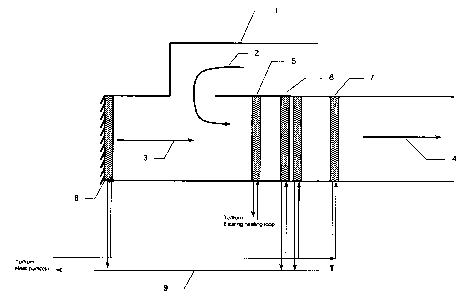Une partie des informations de ce site Web a été fournie par des sources externes. Le gouvernement du Canada n'assume aucune responsabilité concernant la précision, l'actualité ou la fiabilité des informations fournies par les sources externes. Les utilisateurs qui désirent employer cette information devraient consulter directement la source des informations. Le contenu fourni par les sources externes n'est pas assujetti aux exigences sur les langues officielles, la protection des renseignements personnels et l'accessibilité.
L'apparition de différences dans le texte et l'image des Revendications et de l'Abrégé dépend du moment auquel le document est publié. Les textes des Revendications et de l'Abrégé sont affichés :
| (12) Demande de brevet: | (11) CA 2572418 |
|---|---|
| (54) Titre français: | METHODE D'APPROVISIONNEMENT EN ENERGIE DES THERMOPOMPES DANS LES REAMENAGEMENTS DES IMMEUBLES |
| (54) Titre anglais: | METHOD OF SUPPLYING HEAT PUMP ENERGY IN BUILDING RETROFITS |
| Statut: | Réputée abandonnée et au-delà du délai pour le rétablissement - en attente de la réponse à l’avis de communication rejetée |
| (51) Classification internationale des brevets (CIB): |
|
|---|---|
| (72) Inventeurs : |
|
| (73) Titulaires : |
|
| (71) Demandeurs : |
|
| (74) Agent: | |
| (74) Co-agent: | |
| (45) Délivré: | |
| (22) Date de dépôt: | 2006-12-27 |
| (41) Mise à la disponibilité du public: | 2008-06-27 |
| Licence disponible: | S.O. |
| Cédé au domaine public: | S.O. |
| (25) Langue des documents déposés: | Anglais |
| Traité de coopération en matière de brevets (PCT): | Non |
|---|
| (30) Données de priorité de la demande: | S.O. |
|---|
Heat pumps, either air-source or ground source, provide a highly efficient
means of
delivering space heating and cooling. Typical solutions for retrofiting heat
pumps to
existing buildings' heating system are often costly and/or limits the
effectiveness of the
heat pump's ability to deliver heat to the building. The nature of the
invention consists
of delivering heat pump derived energy to the building through its ventilation
system.
Specially, heating/cooling coils supplied by the heat pump are installed
either in,
upstream or downstream of the building's air handling unit(s) (AHUs). The heat
pump
supplied coils thereby can provide base-level heating to the building via the
ventilation
air, essentially utilizing the ventilation system as a forced-air heating
system. The
process of adding heat coils and associated piping loop to the building's
ventilation is a
relatively minor retrofit, causing limited building disturbance and is an
inexpensive
retrofit.
Note : Les revendications sont présentées dans la langue officielle dans laquelle elles ont été soumises.
Note : Les descriptions sont présentées dans la langue officielle dans laquelle elles ont été soumises.

2024-08-01 : Dans le cadre de la transition vers les Brevets de nouvelle génération (BNG), la base de données sur les brevets canadiens (BDBC) contient désormais un Historique d'événement plus détaillé, qui reproduit le Journal des événements de notre nouvelle solution interne.
Veuillez noter que les événements débutant par « Inactive : » se réfèrent à des événements qui ne sont plus utilisés dans notre nouvelle solution interne.
Pour une meilleure compréhension de l'état de la demande ou brevet qui figure sur cette page, la rubrique Mise en garde , et les descriptions de Brevet , Historique d'événement , Taxes périodiques et Historique des paiements devraient être consultées.
| Description | Date |
|---|---|
| Le délai pour l'annulation est expiré | 2011-12-28 |
| Demande non rétablie avant l'échéance | 2011-12-28 |
| Inactive : Demande ad hoc documentée | 2011-09-29 |
| Réputée abandonnée - omission de répondre à un avis sur les taxes pour le maintien en état | 2010-12-29 |
| Lettre envoyée | 2010-08-09 |
| Inactive : Lettre officielle | 2010-02-25 |
| Exigences de rétablissement - réputé conforme pour tous les motifs d'abandon | 2010-02-05 |
| Réputée abandonnée - omission de répondre à un avis sur les taxes pour le maintien en état | 2009-12-29 |
| Demande publiée (accessible au public) | 2008-06-27 |
| Inactive : Page couverture publiée | 2008-06-26 |
| Inactive : CIB en 1re position | 2007-03-28 |
| Inactive : CIB attribuée | 2007-03-28 |
| Inactive : CIB attribuée | 2007-03-28 |
| Inactive : CIB attribuée | 2007-03-28 |
| Inactive : Lettre officielle | 2007-02-02 |
| Demande reçue - nationale ordinaire | 2007-01-30 |
| Exigences de dépôt - jugé conforme | 2007-01-30 |
| Inactive : Certificat de dépôt - Sans RE (Anglais) | 2007-01-30 |
| Déclaration du statut de petite entité jugée conforme | 2006-12-27 |
| Date d'abandonnement | Raison | Date de rétablissement |
|---|---|---|
| 2010-12-29 | ||
| 2009-12-29 |
Le dernier paiement a été reçu le 2010-02-05
Avis : Si le paiement en totalité n'a pas été reçu au plus tard à la date indiquée, une taxe supplémentaire peut être imposée, soit une des taxes suivantes :
Veuillez vous référer à la page web des taxes sur les brevets de l'OPIC pour voir tous les montants actuels des taxes.
| Type de taxes | Anniversaire | Échéance | Date payée |
|---|---|---|---|
| Taxe pour le dépôt - petite | 2006-12-27 | ||
| TM (demande, 2e anniv.) - petite | 02 | 2008-12-29 | 2008-11-14 |
| TM (demande, 3e anniv.) - petite | 03 | 2009-12-29 | 2010-02-05 |
| Rétablissement | 2010-07-16 |
Les titulaires actuels et antérieures au dossier sont affichés en ordre alphabétique.
| Titulaires actuels au dossier |
|---|
| FOREST K. PEARSON |
| Titulaires antérieures au dossier |
|---|
| S.O. |